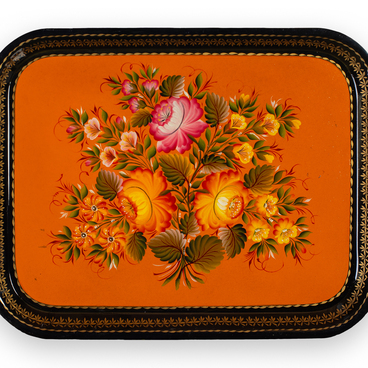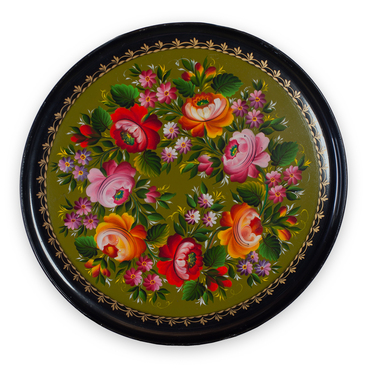The original painting “Portrait of a Kostroma Peasant” was made by Stepan Fyodorovich Khudoyarov (Fyodorov) (1810–1865), a representative of the third generation of the Nizhny Tagil artistic dynasty of Khudoyarovs. He created this work in the 1830s.
There is a copy of this painting in the Museum of Tray Painting History. In 1986, it was made by Alexander Nikolayevich Snyatkov, an artist of the Training Center of Painting and Design Art of the Art Foundation of the Leningrad Region upon commission of the Nizhny Tagil Museum.
In the center of the portrait, there is a half-length image of a peasant. The artist managed to convey the state of pious inspiration and inner prayer. The peasant is dressed in a traditional peasant’s coat (“armyak”). It was a kind of overcoat, a long-sleeved garment with a hood, without buttons. Usually, it was wrapped with a belt.
An armyak was made of a coarse hand-made gray or brown woolen fabric — “armyachina”, or “sermyaga”. Armyaks were worn in winter. In Russia, such garments were known since the 13th century and were considered typical peasant clothes. In the 19th century, the “gray armyak” was a symbol of the lower classes.
For a long time, nothing was known about the original work. In 1937, the portrait was discovered in Moscow by the private collector Fyodor Iosifovich Podtynnikov. The painting was created by Fyodorov, a serf artist. The work was presented in the Bolshoi Theater at an exhibition dedicated to the production of Mikhail Ivanovich Glinka’s opera “Ivan Susanin”. It aroused great public interest in the artist’s personality. After a request to the Nizhny Tagil Museum of Local Lore, the name and family name of the artist became known.
The biography and creative work of this serf artist were not sufficiently studied. It is known that he was born into the family of famous Nizhny Tagil artists in 1810. He graduated from the Vyysk school, where he showed great ability. In 1827, he was sent to Italy to study painting with the famous Karl Pavlovich Bryullov. In 1830, Stepan Khudoyarov was mentioned in correspondence under the surname Fyodorov. In 1832, he returned to Russia. His further creative activity unfolded in St. Petersburg, cities of Italy and Germany. He made copies of paintings by the great masters in Dresden and Rome.


